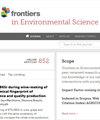基于超效率 SBM-Tobit 模型的中国城市污水处理效率测量及影响因素研究
IF 3.3
3区 环境科学与生态学
Q2 ENVIRONMENTAL SCIENCES
引用次数: 0
摘要
随着城市化进程的加快,确保城市用水安全和水资源可持续管理已成为全球面临的重大挑战。作为一个人口大国,中国面临着日益严峻的挑战。全面系统的城市污水处理效率(UWTE)评估是解决这一问题的前提。基于 2011-2021 年中国 30 个省份的面板数据,采用超效率 SBM 模型,从国家和区域角度对城市污水处理效率进行测算。采用 ArcGIS 软件和 Tobit 模型分析了 UWTE 的时空格局和影响因素。大部分省份的UTE总体呈波动上升趋势,空间分布呈现东高西低的不均衡格局。分解结果表明,东部地区 UWTE 偏低主要受规模效率制约,而中部地区纯技术效率是主要制约因素。分流管道建设水平、负荷率和污水处理规模对 UWTE 有显著的正向影响,而经济规模则产生了负向影响。建议中国政府调整过时的 "只建设不运营 "模式,实施差别化污水处理政策。要大力推进雨污分流管道建设,优化升级污水管网和污水处理设施,充分发挥规模效应。这些研究结果为中国以及与中国类似的国家促进高效的污水处理实践提供了启示。本文章由计算机程序翻译,如有差异,请以英文原文为准。
A study on the measurement and influencing factors of the urban wastewater treatment efficiency in China based on the superefficiency SBM-Tobit model
With urbanization acceleration, ensuring urban water use security and sustainable water resource management has become a major global challenge. As a populous country, China faces increasingly severe challenges. Comprehensive and systematic urban wastewater treatment efficiency (UWTE) assessments constitute a prerequisite for addressing this problem. Based on 2011–2021 panel data of 30 Chinese provinces, the superefficiency SBM model was employed for UWTE measurement from national and regional perspectives. ArcGIS software and the Tobit model were adopted to analyse the spatial-temporal patterns and factors influencing UWTE. UWTE in most provinces generally exhibited a fluctuating upward trend, with an uneven east-high and west-low spatial distribution pattern. The decomposition results showed that the low UWTE in the eastern region was mainly constrained by scale efficiency, while in the central region, pure technical efficiency was the primary constraint. The shunt pipeline construction level, load rate, and wastewater treatment scale significantly positively impacted UWTE, while economic scale yielded a negative impact. It is recommended that the Chinese government adjust the outdated construction-without-operation model and implement differentiated wastewater treatment policies. It is necessary to vigorously promote rainwater and wastewater diversion pipeline construction, optimize and upgrade sewer networks and wastewater treatment facilities, and fully utilize scale effects. These findings provide insights for China and countries similar to China to facilitate efficient wastewater management practices.
求助全文
通过发布文献求助,成功后即可免费获取论文全文。
去求助
来源期刊

Frontiers in Environmental Science
Environmental Science-General Environmental Science
CiteScore
4.50
自引率
8.70%
发文量
2276
审稿时长
12 weeks
期刊介绍:
Our natural world is experiencing a state of rapid change unprecedented in the presence of humans. The changes affect virtually all physical, chemical and biological systems on Earth. The interaction of these systems leads to tipping points, feedbacks and amplification of effects. In virtually all cases, the causes of environmental change can be traced to human activity through either direct interventions as a consequence of pollution, or through global warming from greenhouse case emissions. Well-formulated and internationally-relevant policies to mitigate the change, or adapt to the consequences, that will ensure our ability to thrive in the coming decades are badly needed. Without proper understanding of the processes involved, and deep understanding of the likely impacts of bad decisions or inaction, the security of food, water and energy is a risk. Left unchecked shortages of these basic commodities will lead to migration, global geopolitical tension and conflict. This represents the major challenge of our time. We are the first generation to appreciate the problem and we will be judged in future by our ability to determine and take the action necessary. Appropriate knowledge of the condition of our natural world, appreciation of the changes occurring, and predictions of how the future will develop are requisite to the definition and implementation of solutions.
Frontiers in Environmental Science publishes research at the cutting edge of knowledge of our natural world and its various intersections with society. It bridges between the identification and measurement of change, comprehension of the processes responsible, and the measures needed to reduce their impact. Its aim is to assist the formulation of policies, by offering sound scientific evidence on environmental science, that will lead to a more inhabitable and sustainable world for the generations to come.
 求助内容:
求助内容: 应助结果提醒方式:
应助结果提醒方式:


